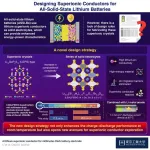(Press-News.org) UNIVERSITY PARK, Pa. — Mobile phone data are increasingly used in public health management and disease outbreak response, as demonstrated during the COVID-19 pandemic when location data were used as a proxy for human movement and contacts and informed exposure notification apps. However, a new study led by researchers at Penn State revealed that phone data may not accurately reflect under-resourced or particularly vulnerable populations, who are often underrepresented in other data as well.
If this bias is not acknowledged or complemented with additional data, the researchers said, a reliance on phone data in public health efforts could magnify health inequities. They published their findings today (July 6) in PLOS Digital Health.
“Populations with limited access to health care are also often overlooked in other data sources, including censuses,” said Nita Bharti, associate professor of biology in the Penn State Eberly College of Science and leader of the research team. “New, convenient data sources like mobile phones can offer important insights into these populations, but it is critical that we identify and measure their biases.”
Data gaps exist in all contexts and can be easily seen in small, rural populations, according to Bharti. In this study, the researchers investigated phone ownership, mobility and access to health care in a mobile, rural population in Namibia as a case study to measure mobile phone data representativeness in populations that regularly experience vaccine-preventable infectious diseases.
Namibia is a middle-income country in southern Africa, and Bharti said mobile phone data from the region are used to guide public health decisions around malaria and other infectious diseases. Most Namibians live in urban areas with reliable access to health care, but this is not the case for rural or remote populations. The research team conducted detailed surveys of more than 250 people at two settlements in a remote area of the Kunene province. Residents are largely nomadic, moving seasonally to herd cattle, and the distance to the nearest health clinic is substantial.
The researchers found that phone ownership was relatively low, with only 31% of participants owning a phone — compared to the estimated 95% in urban areas in the country in 2013 — and only 59% having used a phone in their lifetime. Phone owners and users were far more likely to be men, to travel to more locations and to have better access to health care.
“We found that, within these already vulnerable populations, the most vulnerable people were underrepresented in these phone data because they didn’t own phones or have access to phones,” said Alexandre Blake, graduate student in Bharti’s lab at Penn State and first author of the paper. “One common way to make up for missing data is to simply scale it up and assume that missing data are the same as recorded data. But we distinctly found that the people missing in phone data are less mobile with reduced access to health care. And with respect to making public health decisions, these are very important differences.”
Mobile phones also provided a skewed perception of mobility among phone owners, according to Blake. Because phone owners frequently traveled to areas with no phone reception, many of their movements would not be captured in phone data.
“Even if you own a phone, you can only be tracked in locations where you get signal,” Blake said. “So, phone data, especially from remote areas, will only capture a specific segment of the population and can record only some of their movements. If phone data were used to predict the potential spread of an infectious disease in a region like the one we studied, most movements and contacts would be missed. Without accounting for data biases, movements based on phone data would be misleading and ineffective for outbreak response efforts attempting to limit the spatial spread of a disease.”
Because mobile phone data may not accurately represent the populations and locations that most need public health improvements, the researchers suggested that relying on these data to inform public health decisions can actually be harmful and potentially magnify health inequalities. They stressed the importance of acknowledging and measuring bias in all types of data — not only those used for public health — as well as using multiple types of data with non-overlapping biases when drawing conclusions.
“All data have biases but are still valuable resources, and phone data are no exception,” Bharti said. “Acknowledging that data are not just under representative and showing that they are in fact biased helps our field move towards correctly interpreting data, measuring biases and looking for ways to measure what’s missing.”
According to the researchers, small, remote populations play an important but often overlooked role in the transmission and persistence of infectious disease. Limited access to health care can lead to delayed detection of outbreaks, and overlooking these groups can slow the elimination of vaccine-preventable transmissible pathogens.
“Equitable access to health care is a basic human right, and addressing health inequities in underrepresented populations is essential for public health progress,” Bharti said. “You don’t have to look to low- or middle-income nations to find underrepresentation in vulnerable groups. We would see the same absence of vulnerable groups in widely used data if we looked, for example, at a rural part of Pennsylvania or Mississippi or in urban areas, like New York City or Los Angeles. There are gaps and biases in all data that underrepresent the segments of populations most in need of improved health services. Failing to acknowledge these biases can direct resources away from these groups and lead to public health interventions that magnify inequities.”
In addition to Bharti and Blake, the research team includes Ashley Hazel at the University of California, San Francisco, and John Jakurama and Justy Matundu at the Kaoko Information Center in Namibia. This research was supported by the Branco-Wiess Society in Science Fellowship; the Penn State Huck Institutes of the Life Sciences; the multi-agency Ecology and Evolution of Infectious Disease program from the National Institutes of Health, National Science Foundation and National Institute of Food and Agriculture; and the National Science Foundation.
END
Mobile phone data used for public health underrepresent vulnerable populations
Phone data that don't account for under-resourced populations could magnify health inequities, according to a new study.
2023-07-06
ELSE PRESS RELEASES FROM THIS DATE:
Researchers discover potential molecular indicators for Parkinson’s symptoms
2023-07-06
Hand tremors and slowed movements are two of the most widely recognized hallmarks of Parkinson’s disease, and for many sufferers the first indication that something is amiss. But by the time these symptoms manifest, those patients have already lost 50–80 percent of their dopamine neurons—a mass die-off that causes the neurodegenerative disease. Malfunctions in dopamine-dependent areas of the brain are responsible for many of the symptoms, which differ from person to person in an unpredictable way.
A diagnosis at an early age, typically before age 50, can stave off the most severe symptoms for years; when the disease is identified later, its trajectory is often swift ...
Study supports “catch up” HPV test in older women
2023-07-06
For women over the age of 65 who have never had a high-risk human papillomavirus (HPV) test, a “catch up” HPV screening intervention may improve cervical cancer prevention by detecting more cervical pre-cancer lesions as compared to women not offered screening. That is the conclusion of a new study publishing July 6th in the open access journal PLOS Medicine by Mette Tranberg, University Research Clinic for Cancer Screening, Randers Regional Hospital, Denmark, and colleagues.
High-risk human papillomavirus (HPV) test is replacing cytology as the primary cervical cancer screening test in most countries, but many women over 65 years have never had an HPV ...
The solstice switch: Warming’s effects on autumn leaf senescence depend on timing
2023-07-06
How temperate and boreal trees’ leaves respond to climate change remains uncertain. Now, a new study of northern forests reports that while early-season climate warming – that occurring before the summer solstice – tends to be associated with earlier autumn leaf senescence, late-season warming (after the summer solstice) has the opposite impact, delaying onset of leaf senescence in fall. “Improved models of plant development and growth under climate change will need to incorporate the reversal of warming effects after the summer solstice,” write Constantin Zohner and colleagues, authors of the study. Climate change ...
Two studies report: Perovskite-silicon tandem cells that break the 30% efficiency threshold
2023-07-06
In two separate studies, researchers present novel methods that enable the fabrication of high-performance perovskite-silicon tandem solar cells with power conversion efficiencies exceeding 30%. Silicon solar cells – the most commonly deployed photovoltaic (PV) technology – are rapidly approaching their theoretical power conversion efficiency (PCE) limit of 29%. One way to increase the efficiency of a solar cell is to optimize the spectrum of sunlight for conversion into energy. This can be done by stacking two or more interconnected photoactive materials into a singular device, improving ...
Precipitation tolerance helped explain which vertebrate species spread between newly joined continents
2023-07-06
A new study helps explain why rates of species exchange are at least twice as high from west to east than in the opposite direction across Wallace’s Line. The study included an analysis of more than 20,000 species belonging to all 227 families of terrestrial vertebrates present in the Indo-Australian archipelago. As tectonic plates merge, once disparate continents can connect and create new opportunities for biotic exchange. Species movement across newly connected continents millions of years ago continues to shape assemblages of flora and fauna today. One of the most well-known ...
Ready for its close-up: The electron’s permanent electric dipole moment
2023-07-06
A new study with direct implications for one of the most important unresolved questions in physics – the imbalance of matter and antimatter in our universe – reports “the most precise measurement yet” of the size of the electron’s permanent electric dipole moment. The imbalance between matter and antimatter in the Universe can be explained via the breaking of charge parity symmetry. The standard model (SM) of particle physics predicts a slight breaking of this symmetry, but it is insufficient to explain the imbalance actually observed. Many extensions to the standard ...
Policymakers should consider animal welfare in decisions
2023-07-06
Incorporating animal welfare into policymaking may improve policy and practice, according to Rutgers research.
The article, published in Science, notes that animal welfare rarely is considered during policymaking, explains why current tools make it difficult to incorporate the well-being of animals into public policy and identifies methods for remedying these issues.
“Animal welfare is often ignored in policymaking, despite its relevance across many domains ranging from food systems to biomedical research to climate policy,” said Mark ...
Why you won’t see kangaroos in Java but you will find goannas in Australia
2023-07-06
Ask anyone what first springs to mind when they think of Australia and they’ll most likely say a kangaroo; the marsupial is ingrained in our national identity. But have you ever wondered why kangaroos never ventured beyond our shores?
A major study led by biologists at The Australian National University (ANU) and ETH Zurich in Switzerland provides a new explanation for why you won’t find kangaroos, koalas and other Aussie marsupials in Indonesia, but you will find many groups of animals that originated in Asia, such as goannas, ...
New design rule for high-entropy superionic solid-state conductors
2023-07-06
Solid electrolytes with high lithium-ion conductivity can be designed for millimeter-thick battery electrodes by increasing the complexity of their composite superionic crystals, report researchers from Tokyo Tech. This new design rule enables the synthesis of high-entropy active materials while preserving their superionic conduction.
As the world transitions towards a greener and more sustainable energy economy, reliance on lithium (Li)-ion batteries is expected to rise. Scientists from across the globe are working towards designing smaller yet efficient batteries that can keep up with the ever-increasing demand for energy ...
Why there are no kangaroos in Bali (and no tigers in Australia)
2023-07-06
If you travel to Bali, you won’t see a cockatoo, but if you go to the neighbouring island of Lombok, you will. The situation is similar with marsupials: Australia is home to numerous marsupial species, such as the kangaroo and the koala. The further west you go, the sparser they become. While you will find just two representatives of these typically Australian mammals on the Indonesian island of Sulawesi, you will search in vain for them on neighbouring Borneo. Australia, on the other hand, is not home to mammals that you will typically find in Asia, such as bears, tigers ...
LAST 30 PRESS RELEASES:
Researchers identify gene that calms the mind and improves attention in mice
Artificial metabolism turns waste CO2 into useful chemicals
Ancient sea anemone sheds light on animal cell type evolution
Begging gene leads to drone food
How climate policies that incentivize and penalize can drive the clean energy transition
Can community awareness campaigns in low-resource areas improve early diagnosis of colorectal cancer?
Stardust study resets how life’s atoms spread through space
Practical education: Clinical scenario-based program development
The impact of family dynamics on eating behaviour – how going home for Christmas can change how you eat
Tracing the quick synthesis of an industrially important catalyst
New software sheds light on cancer’s hidden genetic networks
UT Health San Antonio awarded $3 million in CPRIT grants to bolster cancer research and prevention efforts in South Texas
Third symposium spotlights global challenge of new contaminants in China’s fight against pollution
From straw to soil harmony: International team reveals how biochar supercharges carbon-smart farming
Myeloma: How AI is redrawing the map of cancer care
Manhattan E. Charurat, Ph.D., MHS invested as the Homer and Martha Gudelsky Distinguished Professor in Medicine at the University of Maryland School of Medicine
Insilico Medicine’s Pharma.AI Q4 Winter Launch Recap: Revolutionizing drug discovery with cutting-edge AI innovations, accelerating the path to pharmaceutical superintelligence
Nanoplastics have diet-dependent impacts on digestive system health
Brain neuron death occurs throughout life and increases with age, a natural human protein drug may halt neuron death in Alzheimer’s disease
SPIE and CLP announce the recipients of the 2025 Advanced Photonics Young Innovator Award
Lessons from the Caldor Fire’s Christmas Valley ‘Miracle’
Ant societies rose by trading individual protection for collective power
Research reveals how ancient viral DNA shapes early embryonic development
A molecular gatekeeper that controls protein synthesis
New ‘cloaking device’ concept to shield sensitive tech from magnetic fields
Researchers show impact of mountain building and climate change on alpine biodiversity
Study models the transition from Neanderthals to modern humans in Europe
University of Phoenix College of Doctoral Studies releases white paper on AI-driven skilling to reduce burnout and restore worker autonomy
AIs fail at the game of visual “telephone”
The levers for a sustainable food system
[Press-News.org] Mobile phone data used for public health underrepresent vulnerable populationsPhone data that don't account for under-resourced populations could magnify health inequities, according to a new study.





